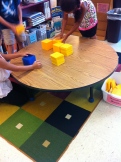Recently, an Albemarle staff team visited the engineering school at the University of Virginia. It was an eye-opening experience, similar in many ways to what we learned on a similar visit to the Claude Moore Medical Education facility, just a few blocks away. We toured labs in the Department of Mechanical and Aerospace Engineering and chatted with students, faculty, and the chair of the department who also is a parent of students in our schools. During the visit, we had a chance to observe the process of 3-D printing of a wrench from ABS plastic, representative of the future of advanced manufacturing.
We also spoke with two engineering students who have recently designed, printed, and constructed a small, working drone plane which they’ve taken on multiple test flights this fall. We heard about the collaborative efforts with faculty in other School of Engineering departments, the College of Liberal Arts and Sciences, and the School of Medicine. When we saw orthopedic body parts printed in 3-D, we realized that the possibilities of what can be designed and made through advanced manufacturing likely will be America’s next wave of innovation.
What we also heard very clearly from the engineering professors was that this field of engineering demands technicians and engineers who are comfortable with a kind of mathematical thinking that’s different from the way that pre-college students typically learn math. Instead of learning what one professor referred to as “pattern” math from formulaic teaching and textbooks, students need to have deep conceptual understanding of how math applies to the real world. Designing and making things – whether constructing with Legos or bridge building – is one way to develop mathematical thinkers, not arithmetic users. It’s why our schools are exploring how to provide space for those kinds of activities within instructional programming.
Educators in our schools work to provide more opportunities for students to design, create, engineer, and construct projects consistent with both the Virginia standards and local curricula, projects similar to the kind of work going on in the School of Engineering.
We know space matters. The tools that learners need to construct matter, too. However, teachers matter the most. They are key to supporting learners to acquire both the knowledge and competencies to think critically and creatively. It’s why we invest in professional training, not just school renovations and technologies. The National Academies Press recently released a report on Education for Life and the Work: Developing Transferable Knowledge and Skills for the 21st Century. Researchers identified competencies that young people need to be able to transfer learning to new situations in the report. These competencies overlap with what we in Albemarle refer to as lifelong learner competencies.
Stony Point Elementary staff have been working to consistently craft learning experiences that deepen the knowledge and competencies that students need for success in life and work. In a recent post, principal Carrie Neeley described this ongoing work by staff, parents, and volunteers to redesign space inside and outside the school for staff to use with students to develop the kind of competencies needed by young people to pursue any career they desire, including ones emerging from new economies such as advanced manufacturing. Mrs. Neeley’s post follows:
Stony Point Elementary School
By Carrie Neeley, Principal

This year, Stony Point will be doing some research around the theme of “learning spaces.” If you have not had a chance to visit our new i-space (formerly known as the computer lab), we hope you can check it out on your next visit. As I mentioned in our State of the School Address, one of the things I look for as I do learning walks in our classrooms is, “To what extent are students engaged in learning?” Are students engaged in a lesson to the point where they would continue working even if they thought no adult was watching? Hopefully, all of us can think of a time when we were so involved in learning a new concept or subject that learning in and of itself, was its own reward. Providing a learning space that allows students to experience choice and provides students with a variety of technology to assist in the learning process can greatly increase student engagement, which in turn makes learning fun (even/especially when it is challenging)!
In addition to the i-space, our United Way Day of Caring Volunteer Group (a UVA Technology Team) worked to clear our “Sculpture Garden,” which had become overgrown and unavailable for learning. We are looking forward to creating another outdoor space (in addition to our Japanese Garden and our Nature Trail) for learning, possibly with a math theme. If you are interested in working with us on this project, please contact Allison Mitchell at mitchellmimi@gmail.com. We are looking forward to this new endeavor in our learning community!
When the attention to the learning environment pairs with the attention to a carefully crafted learning experience, great things happen for students. We know that our children will go on to engage in careers we can’t even imagine at this point in time. Our goal is to prepare learners to take on any challenge their passions inspire!
As always, THANK YOU for the incredible support you provide for Stony Point Elementary!

